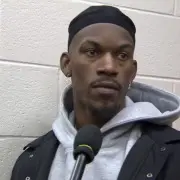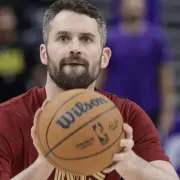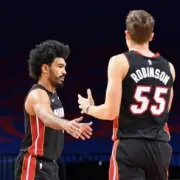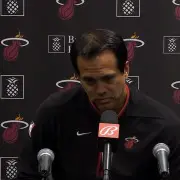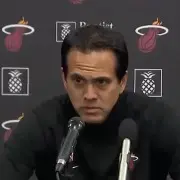Let’s cut right to the chase. I’m frustrated. You are frustrated. The Miami Heat’s activity – or lack thereof – over the last two seasons has been perplexing. I’ve been a passionate fan since 2004 (I’m 28 years old), and I cannot remember a time when the fanbase felt this defeated. And that’s saying something because I was around for the Stephane Lasme days. (Shoutout to him).
As taxing of a season as this has been, it’s not where most of the disappointment lies. Actually, it’s quite the contrary. The frustration mostly lies with the front offices’ unwillingness (or inability) to maximize this build.
Since Jimmy Butler was traded to Miami back in 2019, we’ve enjoyed two trips to the Conference Finals and fell one shot short of a second NBA Finals appearance last Spring. Championship pedigree was evident with this core. And success in the postseason gave this city a glimpse of what was possible with the correct additions.
After Butler’s shot rimmed out in Game 7 of the Conference Finals, it’s felt that this franchise has gone backward.
The only moves – offseason or free agency – completed in Miami have been the re-signing of Victor Oladipo and the re-signing and trade of Dewayne Dedmon. The latter was just sent to the San Antonio Spurs with a second-round pick in exchange for cash considerations and a box of fig newtons.
To make matters worse, we’ve had to stand by and watch other contending Eastern Conference teams make additions that move their needle. The Boston Celtics added Malcolm Brogdon, Derrick White, and Mike Muscala. The Philadelphia 76ers added James Harden, De’Anthony Melton, P.J. Tucker, and Jalen McDaniels. The New York Knicks (man I hate the Knicks) added Jalen Brunson and Josh Hart. The Milwaukee Bucks added Jae Crowder. You get the point.
This all culminated on Thursday at 3:01 PM ET. The trade deadline came and went. And just like that, Miami stood pat (pun very much intended).
So where do we go from here?
First, I’ll tell you where we’re not going to go. We’re not going to dwell on the past. This isn’t the Sixers franchise. I’m not going to sit here and revoke your right to disappointment because this roster has overachieved in two of the last three postseasons. I’m not going to type some overused “In Pat we trust” slogan and expect everyone to put on a happy face and accept the current circumstance.
On the same token, I’m not going to bash the front office either. As of the time of this writing (Friday afternoon), there are 27 games remaining. And this team deserves our full focus as they push for a top 5 seed.
Despite not acquiring another piece, here are a few notable things to watch for moving forward.
What Kind Of Spark Can Omer Yurtseven Provide?
Last season, Victor Oladipo made his return to the lineup shortly after the trade deadline. His presence gave a huge boost to Miami’s depth and ultimately paid large dividends during the postseason.
Can Yurtseven have the same impact?
Yurt hasn’t played a minute this season and underwent ankle surgery in November. When asked Thursday about the timeline to return to the court, Erik Spoelstra said, “I don’t have an answer, I just like the progress. Things in our center position are trending in a much better direction.”
Despite Spo not having a direct answer, by all accounts, his return to the lineup is drawing near. It was just last week that he was cleared for “high-impact work”.
The big question will be if/how he can coexist with Bam Adebayo. Looking at last season, the two big men only shared the court for a total of 34 possessions. It wasn’t pretty.
While a small sample, Miami was a minus 27.5 points per 100 possessions.
Interestingly enough, a quote from Yurtseven during the Heat’s media day is worth delving into. In explaining why he should play alongside Bam more, his response was this:
“I can put Bam in his more natural position… Which would also allow him to be more aggressive.”
Bam and aggressive. Those two words together will make every Heat fan perk up.
With Bam now a bonafide threat from midrange, opening him up to catch the ball outside the paint could unlock an entire brand of offense for Miami. Giving him room to attack his defender off the dribble will surely open things up along the perimeter.
Defensively, it could bring a whole new persona. If Yurt is down low manning the paint, Bam now has the freedom to stay up top and switch everything. Simply having a non-negative big on the court alongside Bam allows Miami to utilize Bam’s defensive versatility to their advantage.
At the very least, Yurtseven’s presence should bolster the Heat’s frontcourt depth. It was clear that Dedmon was just a walking talking negative every single time he stepped on the floor. Miami was getting obliterated in non Bam minutes as a result. The hope here is that Yurt can step in and be the bridge down low that keeps Miami afloat when Bam is on the bench.
Bam was asked earlier this season what it’s like playing alongside some of his teammates, and he specifically brought up playing with Yurt:
“But Big 77 [Yurtseven], I’ve got to be aware of where I’m at, just to keep the spacing and keep us in sync, to where if he’s spacing, I’m in the paint. Or if he’s in the dunker’s [spot], I’m in the corner.”
It remains to be seen how often Spoeltra will employ the two at the same time – especially with Yurt getting back into the swing of things. But simply having him available is a huge positive for Miami’s offensive and defensive versatility.
How Can Nikola Jovic Contribute This Season?
Miami’s only acquisition this season has been Nikola Jovic. While only 19 years old, he’s shown flashes of high-level play during Summer League and the preseason. He’s currently out with a back injury but should be re-evaluated any day.
The first question here is *can* Jovic be of value this season? After all, he’s young and his growing pains were on full display during the 15 games in which he saw the court.
One way I would like to see Miami utilize him when healthy is in a PnR scenario with Bam. Jovic is 6-foot-10 but has mostly guard skills. With him on the ball and Bam screening, it could create some mismatches for opposing defenses. The Denver Nuggets do a great job at this with Nikola Jokic and Aaron Gordon. The 4 screening for the 5 or vice versa is something that not a lot of teams like to deal with. And Jovic has a better jump shot than Gordon.
If Bam screens and defenses switch, Jovic can use his ball handling and speed to attack a bigger, slower defender. It also puts a smaller defender on Bam. If defenses play drop, Jovic has shown he is comfortable enough to take the shot. And if defenses fight through, Jovic could force a 2-on-1.
If the latter happens, Jovic has already proved himself to be a talented and willing passer. Especially on lobs. Just check out some of these passes from the preseason:
There will be growing pains. I’m not expecting Jovic to heal and become prime Kevin Durant overnight. But his playmaking skills and length could create some mismatches for opposing defenses.
Duncan Robinson’s Confidence Needs Rebuilding
In his heyday, Robinson was one of the deadliest sharpshooters in the league. Unfortunately, that heyday lasted only a season. Since then, it’s been a grind. Teams have caught on and when he’s not making threes, his shortcomings on defense make him a liability on the floor. As a result, his role has diminished and his confidence has noticeably declined.
With that said, Miami needs to be shining the proverbial batman symbol in the sky. Except instead of batman’s logo it looks like Sheen from Jimmy Neutron. Only real ones will get it.
Miami was the best three-point shooting team last season. They are 27th at the time of this writing. By all accounts, Robinson is needed now more than ever.
His game has always seemed mental and Ethan Skolnick brought up a good point on Thursday’s show. Duncan actually played better last season after the trade deadline. It’s been no secret that he’s been mentioned in every trade rumor for the past two seasons and that has to mess with you – simply on a human level.
With the trade deadline behind us and Robinson on the roster at least until the offseason, could that alleviate some pressure when he’s healthy? Could it also take some of the 3pt weight off of Max Strus’s shoulders? Possibly.
At the very least, having a career 40% 3pt shooter on high volume available has to be a good thing for the Heat simply by the law of averages, right?
Gabe Vincent Should Start Regardless Of Kyle Lowry’s Health
This has been debated ad nauseum for much of the last month, but the answer is quite simple. Miami’s starting core is better with Vincent than with Lowry. With Vincent, they are putting up 132.5 points per 100 possessions. Good enough for the 90th percentile. With Lowry, that number dips all the way down to 111.0 points per 100 possessions. That’s the 33rd percentile for those wondering.
Lowry’s presence also affects Tyler Herro. His numbers and efficiency from three improve with Lowry off the court. My theory is that they each feel more comfortable with the ball in their hands. After Herro was inserted into the starting lineup this season, there were one too many ball handlers on the floor. With Vincent in over Lowry, this frees up Herro to play make while also letting Vincent function off the ball – a role he plays well.
But the main reason why Vincent needs to start is that the Heat need to know what they have. This offseason brings with it a very interesting dilemma for the front office. With Strus and Vincent up for extensions, it’s unlikely they’ll be able to afford both. Giving Vincent ample time with this starting unit can help them when it comes time to decide their route.
Do Any Buyout Options Move The Needle This Season?
This is tough to say at the time of this writing, as there will surely be more names bought out over the next two weeks. But looking at the current slate of guys, there are a few options who could help the Heat.
Russell Westbrook
My mom could have told you that Westbrook wasn’t a good fit in Los Angeles. If Miami can get him at a cheap number, he could offer some much-needed juice to Miami’s offense. The turnovers will be there, but the rim pressure he provides could open things up.
Terrance Ross
Ross is my favorite buyout candidate for Miami should he become available. Outside of the fact that he’s been a #RandomHeatKiller more often than not, his offensive game is what Miami needs. He’s only a few years removed from putting up 15.6 points and two threes a game in less than 30 minutes. I would expect him to provide a “Joe Johnson-esque” scoring boost to Miami, which could come up big during postseason dry spells.
Danny Green
This is a risk, given he’s only played three games this season. But the reward could be huge. Green has championship DNA. He can defend and knock down threes at a 40% clip. Those are things Strus and Robinson cannot do simultaneously. It’s likely that Green prefers a squad with better title odds, but he’s an intriguing target.
Ultimately, the Heat is in this pickle due to past mistakes. Bloated contracts and an over-reliance on developing undrafted players with low ceilings will catch up to you sooner than later. Hindsight is 2020. It’s easy to clown moves now when you know the outcome.
The reality is this:
Jimmy Butler will be 34 years old before next season. It feels like Miami’s window to win a ring with him is closing fast. It’s clear that this team cannot keep relying on his Herculean efforts every postseason. It’s unsustainable.
Miami finds itself at a fork in the road this offseason. The direction they go will determine the future of this build. If Miami finds itself watching from home in May, I wouldn’t be surprised to see something drastic take place. After all, it’s becoming clearer and clearer that the future of this team belongs to Bam.
*****
To play Fantasy Sports the right way, use the code “five” at PrizePicks.com to get your initial deposit matched up to $100.
